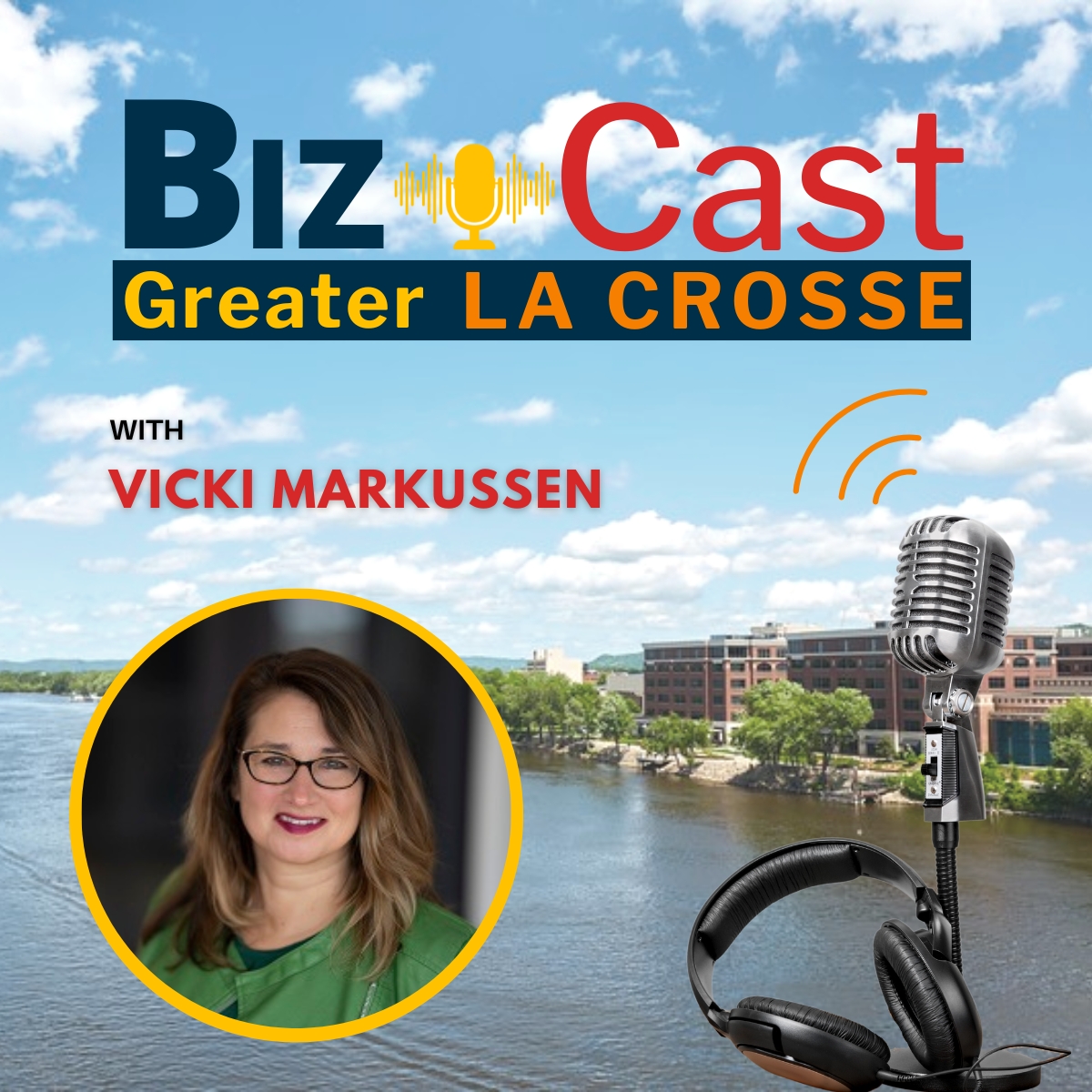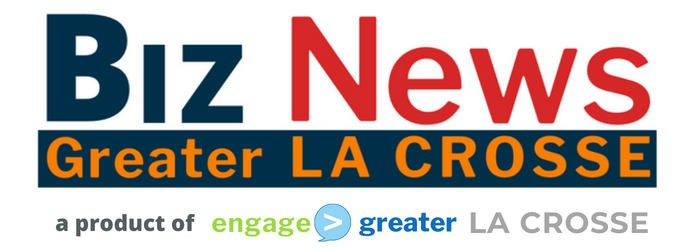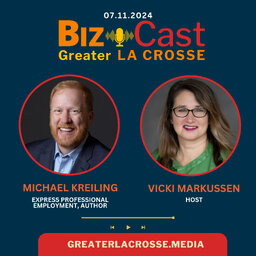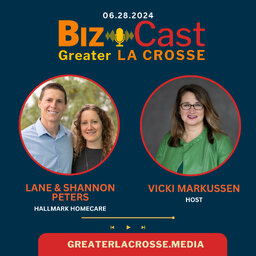
Episode 26
Apprenticeships Beyond Trades
About BizCast Greater La Crosse
We bring you news from the business community. From startups to experienced problem solvers, you’ll get in-depth insight on the challenges and opportunities of doing business in Greater La Crosse. Our show is a collaboration between WIZMNews.com and BizNews Greater La Crosse ( GreaterLaCrosse.media ).
Full Transcript [ generated by AI]
[00:00:02] Amanda Langrehr: I can confidently say that all 26 school districts within the Cooley region offer some form of work-based learning experiences. It’s just a matter of connecting,
[00:00:10]
[00:00:11] Vicki Markussen: Welcome to Biz Cast Greater La Crosse, a weekly podcast brought to you by Business News, greater Lacrosse. We bring you news out of the business community. I am your host and founder, Vicki Markussen, and joining me today is Amanda Langrehr. She is the career and technical Education Director with CESA 4 of which probably a small percentage of people listening.
[00:00:35] Vicki Markussen: Understand what CESA 4 is. So let’s start there. How does CESA 4 service
[00:00:40] Amanda Langrehr: our community? I am thankful to be able to join all of you today. CESA 4 really serves as a cooperative education service agency that helps support all of our school districts, essentially as the go between, between the Department of Public Instruction and all of our school districts.
[00:00:55] Amanda Langrehr: And
[00:00:55] Vicki Markussen: one of those programs, which is what we wanna talk about, is what you oversee, which is the apprenticeships the workforce engagement. Like your job is to get our kids active into
[00:01:08] Amanda Langrehr: local jobs. Absolutely. The biggest and probably best part of my job is working with students today to help them figure out what it is they want to do after they leave us in high school, students today really are facing a significantly different and ever changing world than what we could have ever imagined.
[00:01:26] Amanda Langrehr: The jobs today that exist are not the jobs that are gonna exist tomorrow and in the future, we can only imagine what our kids are going to be doing. And so we wanna ensure that our students are prepared to change and be flexible. As they are making those decisions.
[00:01:40] Vicki Markussen: And you’re not doing that directly because you have a lot of schools that you work with, correct?
[00:01:45] Amanda Langrehr: Correct. I work with 26 school districts throughout the Cooley region to help them really look at what their academic and career planning looks like to help students prepare for that task and prepare for life after high school. So
[00:01:56] Vicki Markussen: a lot of the parents that are listening out there are going, oh, This is what I wanna know to figure out how to get my child into a career.
[00:02:05] Vicki Markussen: And so explain the, we were talking before this about, there’s two routes really. So there’s how do they explore careers and then how do they actually start working in careers? So talk about what. Those programs look like.
[00:02:18] Amanda Langrehr: So a big part of my job is working with students to get them engaged in what we call career-based learning experiences.
[00:02:24] Amanda Langrehr: And through that process we’re gonna start at the very beginning to help students explore and learn about who they are and what their interests and passions are. Take them through things like job shadows and guest, bringing in guest speakers and taking them out and visiting different employers all the way through that engagement piece where they start to understand what it is they want to do.
[00:02:43] Amanda Langrehr: And as they start to move towards that, we’re gonna be looking at more work. Based learning experiences where they’re going to go in and more than just the job shadow, they’re actually doing the hands-on work. So they’re going to engage in things like apprenticeships or internships where they have the opportunity to day by day, go through and learn about what it would be like in a day.
[00:03:03] Amanda Langrehr: In the job of the career that they’re interested in. So
[00:03:06] Vicki Markussen: many of us know it’s a lot of times the parents pushing. Of course there’s amazing career counselors out there. Depending on the school district, there’s more resources than, and others, like we have in lacrosse, the Future Center. And so there’s just some add-ons there.
[00:03:22] Vicki Markussen: But as a parent, How can they ensure that their student connects with these
[00:03:27] Amanda Langrehr: programs? So I will always put this out there as the regional coordinator for the youth apprenticeship program for the Mississippi Valley Consortium. I am always a resource that you can reach out to at any point in time because I can always point you in the right direction with who your coordinator is within your.
[00:03:41] Amanda Langrehr: School district, so I can confidently say that all 26 school districts within the Cooley region offer some form of work-based learning experiences. It’s just a matter of connecting, so feel free to reach out to myself. Otherwise, going directly to your school counselor is a really great start,
[00:03:55] Vicki Markussen: and those career counselors can help the students a lot of times.
[00:04:00] Vicki Markussen: I think it’s, is it required now that there’s career pathways that the students are engaging with? Can you talk about that? While
[00:04:06] Amanda Langrehr: it’s not a requirement, it is something that we highly, highly encourage each and every one of our students to participate in. We do offer regional career pathways, and it’s an opportunity for a student who knows the pathway that they want to pursue to start engaging in things like the relevant coursework industry, recognized credentials, and then of course, those work-based learning experiences that are gonna move the needle on how much experience and knowledge they have.
[00:04:29] Amanda Langrehr: When they leave high school for those career paths, what
[00:04:33] Vicki Markussen: age do a lot of these students start engaging with these programs?
[00:04:37] Amanda Langrehr: So when we talk about academic and career planning, we talk about that as a K-12 experience, but when we look at the work-based learning experiences specifically, we want them to start engaging in those at the high school level.
[00:04:46] Amanda Langrehr: So freshman and sophomore year should be. Exploration, going out and doing job site visits, job shadows, experiencing with guest speakers. And then junior year we really would love for our students to be participating in work-based learning experiences where they’re going out and actually working at the job
[00:05:01] Vicki Markussen: site.
[00:05:01] Vicki Markussen: So talk about that. That’s the youth apprenticeship. And a lot of people, you think of an apprentice, you think of a plumber, an electrician, but that has expanded over time.
[00:05:12] Amanda Langrehr: It has. So the apprenticeship program really encompasses any career pathway that you could imagine, and the Department of Workforce Development has been phenomenal in working with our employers and identifying areas of need so that even though we have 11 current industries that we are focused on with our career clusters, they are expanding.
[00:05:29] Amanda Langrehr: Very, or next week we’re actually looking at the education and training pathway. So I am really passionate and excited that we’re adding that one. But if there is a career interest that your student has, there is a work-based learning experience out there for your student, regardless of the industry, everything from marketing and manufacturing to finance and health.
[00:05:47] Amanda Langrehr: There is a place for those students.
[00:05:49] Vicki Markussen: So what. So when we talk about workplace learning, what does that look
[00:05:53] Amanda Langrehr: like? This is the hands-on real world experience that we want our students to have. I alluded earlier that the job market looks very, very different than it ever did, and it continues to change. But when What we do know is that we want our students to have.
[00:06:08] Amanda Langrehr: The ability to work with others. We know that we want them to be able to solve real world problems and we know that they, we want them to have responsibility and perseverance, and those are the things that we are really pushing in these job experiences as our students go out. It’s not just can they do a simple job, it’s what can they also learn that are those employability skills that are going to help them succeed?
[00:06:29] Amanda Langrehr: Whether they stay within the industry or they decide to pursue something completely different.
[00:06:34] Vicki Markussen: But they, it’s those soft skills as many of us call them. Those things that aren’t just what you learn on the job, it’s how do you work with people really and how do you be accountable? And so they’re learning that, which is many of us realize is invaluable.
[00:06:49] Vicki Markussen: When does this workplace experience happen? Can it happen during schools that after school weekends? What does that
[00:06:54] Amanda Langrehr: look like? Yeah, so most of our districts allow this to look. Really any way. It’s very unique to the students. For the vast majority of our students, they’re actually receiving work release time during the day to go to their job visits.
[00:07:08] Amanda Langrehr: But we have some students that are highly engaged in extracurriculars and sporting activities, and so their youth apprenticeships look very different than what it does for a student that is solely interested in just going to a career and getting that job experience. And so during school, Nights, mornings, weekends, you name it.
[00:07:28] Amanda Langrehr: We have students working a variety of different shifts to really make this apprenticeship program work for them. And what are the criteria? So the specifics, the nitty gritty of the Youth Apprenticeship program is that for a level one student, they are going to work 450 hours throughout the year. So when we say a year, we typically talk about the June 1st through the F the entire next year.
[00:07:51] Amanda Langrehr: So for example, our current youth apprentices for the 2324 school year. Ideally, many of them will start in June or July of 2023. They will wrap up their youth apprenticeship in August of 2024. Now, that’s for a level one. For a level two. Our students are going to be completing 900 hours. We’re simply doubling everything for this expectation.
[00:08:13] Amanda Langrehr: So that would be for our juniors. They would again start that June 1st, 2023, and those students would be wrapping up the August of 2025 in addition to completing those 450 paid. Work hours. I do want to really acknowledge that with the Youth Apprenticeship program, our students are getting paid to learn.
[00:08:30] Amanda Langrehr: They will take relevant coursework as well, so they do need the equivalent of one high school credit for every 450 hours or three college credits for that 450 hours. And then again, that doubles looking ahead to a two year
[00:08:45] Vicki Markussen: student. What’s the benefit of a student doing a level one versus a level two?
[00:08:49] Amanda Langrehr: Really it’s the time spent in the career pathway, and it’s just the experience they’re going to get along the way. Obviously, the sooner we can get students engaged in that, in the youth apprenticeship program, the longer they’re going to have to learn and develop their skills over time. But again, sometimes it’s not until senior year that a student really decides that this route is the route for them.
[00:09:09] Vicki Markussen: And then the paid, is that paid through the employer? Are there other funds available? It
[00:09:14] Amanda Langrehr: is paid directly through the employer. So for all intents and purposes, a youth apprentice is just like every other employer on the job site. The advantage is, is that while you’re working in school, now you have your youth apprenticeship coordinator.
[00:09:27] Amanda Langrehr: Myself as well as the school coordinator who’s going to be there as a support system. So for any parents that are thinking, oh, I don’t know if my student’s ready for this. The apprenticeship program really is perfect because again, you have that direct adult supervisor, both at the school district level as well as on the job site.
[00:09:44] Amanda Langrehr: That’s another requirement of the youth apprenticeship program, is that they have a supervisor onsite who is there to help coach them and guide them as they’re learning through this process.
[00:09:53] Vicki Markussen: And so it’s not just in the age of remote working. They’re not just getting paid and not being held accountable.
[00:09:59] Vicki Markussen: There’s someone at the company that is exactly teaching them side by side, so to speak.
[00:10:04] Amanda Langrehr: So yes, for each of our industries, we have career pathways, and then we have specific. Pathways within each of those industries that our students are pursuing. And for each of those, we have competencies that we actually want students to be checked off on on the end.
[00:10:16] Amanda Langrehr: And that’s actually one of the requirements of a student completing a youth apprenticeship is they’re going through and they’re saying that our students are at an entry level for each of these competencies by the end of it. And all of our school coordinators are really great about working directly with those supervisors to ensure that from day one, We all know what those competencies are that the students are going to accomplish, and that by the end of it, our students are successful with all of those competencies.
[00:10:40] Vicki Markussen: Yeah, so let’s talk about it from the employer perspective. A as well as parents, right? They wanna ensure that things are in school, that they wanna ensure things are being learned. So this isn’t just plunk, here’s your student. You figure it out. Yeah. I’m guessing there’s some resources to help the employers ensure that there’s a positive experience.
[00:10:58] Amanda Langrehr: Absolutely. We provide mentor training for any and all of our employers who join the youth apprenticeship program, and that’s helping them with everything from onboarding. Students, because we know our students are a little different dynamic than some of our adult populations. And so we provide that student onboarding training.
[00:11:13] Amanda Langrehr: We are able to assist along the way with the mentoring and the supervision. We definitely do our weekly and biweekly and monthly check-ins just to ensure that things are going well and if there’s anything that we can support from our end and. Sometimes it’s just those simple reminders to our students.
[00:11:29] Amanda Langrehr: That might sound a little easier coming from our school counselors, our school coordinators, or myself, than it does from the employers. So we’re always there to provide support and we’re there literally every step of the way. So we’re only a phone call or an email away,
[00:11:42] Vicki Markussen: and I’m guessing. Thing too. Some of, I call ’em deliverables, if you will, but those outcomes, yes.
[00:11:47] Vicki Markussen: Those outcomes that the students want to achieve. There’s someone at CISA who can say, here’s the, a great way to shape a marketing apprenticeship. Absolutely. So there’s. Other employers that have paved that path then and then someone can say, here’s how other employers have used the apprenticeship program.
[00:12:05] Vicki Markussen: Absolutely. To have a great experience.
[00:12:07] Amanda Langrehr: Absolutely. Absolutely. And one of the coolest things about the Department of Workforce Development that they have been doing with Youth Apprenticeship program is they have been working directly with the registered apprenticeship program to create a bridge program.
[00:12:17] Amanda Langrehr: And as part of that, they have actually developed those on-the-job learning guides. And those on-the-job learning guides are not developed just by D W D and the resources they bring in, but by our employers. Throughout the state. And so that statewide engagement has really allowed us to have the conversations of what works.
[00:12:33] Amanda Langrehr: Like you said, what is best practice in this, and we are always happy to share that out. So right
[00:12:38] Vicki Markussen: now, and you know this, it’s all about workforce, workforce, workforce. How do you get enough people to fill the open positions? And so bringing up the high school students, if you will, and getting them into the labor participation numbers is, is one of those.
[00:12:52] Vicki Markussen: Statistics, getting them out and working is really vital. And so what are some of those success numbers that you have seen? Have you seen it rising? Because there is a workforce
[00:13:02] Amanda Langrehr: shortage. And I will say even during c o d, we were really fortunate on the western part of the state where we saw some of our partners.
[00:13:08] Amanda Langrehr: Losing numbers in their youth apprenticeship program, we have yet to have a year where we go down. And I will say, and we’ve shared before, we have multiple consortiums throughout our region that we continue to encourage and support. And so while our numbers at the Mississippi Valley have stayed the same, it’s not because we don’t have more.
[00:13:25] Amanda Langrehr: Students participating, it’s because we’re able to help and support local school districts who are pursuing their own consortiums and pushing this project forward. So we all work in collaboration to really continue increasing the number of students that are participating in the Youth Apprenticeship program.
[00:13:38] Amanda Langrehr: And currently we are looking at over 8,300 students throughout this state that are participating in specific to the Cooley region. Over 300 students that continue. As part of the youth apprenticeship program for the 2223 school year.
[00:13:50] Vicki Markussen: And we should talk too, I guess there’s a really important piece that we missed, which is, what is that coverage, Jerry?
[00:13:55] Vicki Markussen: So when you talk about 300 students, where are
[00:13:58] Amanda Langrehr: they? So the region that we specifically work in goes as far north as Alma, as far south as Prairie Sheen really. And then over to the Naida Boston area, and then everywhere in that loop on the western part of the. State here. Yeah. And
[00:14:11] Vicki Markussen: I’m guessing the school districts are seeing value in this cuz they’re an essential partner.
[00:14:15] Vicki Markussen: You can’t, they’re obviously bringing a lot of those students in.
[00:14:19] Amanda Langrehr: And we’re looking at that with the connections that we’re making between our employers and our school districts. It’s a kind of dual benefit program because obviously our school districts are helping build that pipeline, but our employers are part of our communities and an integral part of providing resources to our school districts as well.
[00:14:34] Amanda Langrehr: So as we start to leverage those relationships, we’re seeing some really incredible partnerships come out of it. Yeah, and we
[00:14:40] Vicki Markussen: talked too, cuz I know in prior conversations with businesses, I said, are you using the apprenticeship or the internship programs to help you? Cuz it’s not it’s not just about meeting that immediate need.
[00:14:52] Vicki Markussen: There’s just, I feel a social obligation to develop that next generation of employees. And so how have you seen the business community embrace this program?
[00:15:02] Amanda Langrehr: Yeah, the business community has been amazing. I currently, again, statewide, we have over 5,700 employee. Employers participating in the program throughout the Cooley region.
[00:15:10] Amanda Langrehr: We have nearly 300 employers and more calling every single day to be participating in this program, and I think that really is a testament to how strong our employers feel about how strongly they feel about retaining our own talent. We have phenomenal students and we have phenomenal employers, and if we can make those connections, the idea is, is that even though our students may go away for.
[00:15:31] Amanda Langrehr: School after after high school. We want them to return and we want them to know the amazing opportunities that exist. And I think our employers have recognized that the youth apprenticeship program really can be a great branding opportunity because the more name recognition they can get out there.
[00:15:47] Amanda Langrehr: To our students while they’re already in high school, the more likely they are to return and to pursue careers with them. And those careers might even start while they’re in high school. Ideally, yes.
[00:15:57] Vicki Markussen: And I know there are several employers that use the apprenticeship program to, to glean their future workforce.
[00:16:03] Vicki Markussen: To go, oh, Yeah, we learned through the apprenticeship program we’re gonna keep you and we’re gonna recruit you before you even graduate. Yes. And there’s others that it’s an opportunity to let them pass into the real world, if you will. Absolutely. And it’s that branding as you talked about. So it’s not just, oh, you gain an employee.
[00:16:19] Vicki Markussen: Those students are going back to school, they’re talking to their friends, and their friends are asking, oh, where do you work? And they’re probably saying a name that those. Students would’ve not thought of otherwise. So there is that awareness of the next generation as to what some of these local companies do that they wouldn’t have had
[00:16:35] Amanda Langrehr: before.
[00:16:35] Amanda Langrehr: Yes, and I think one of the coolest things that we see with our local companies too is that they’re snagging some of our really phenomenal students early on in, they’re helping them grow. In their own way through the company. So they start in one position, as a youth apprentice, but they start with that intention of knowing you’re going to be here for this youth apprenticeship program, but we want you to grow and we want you to really build up the career ladder through us and to stay within our organization.
[00:17:02] Amanda Langrehr: And that has been incredibly successful for a large portion of our students.
[00:17:06] Vicki Markussen: Yeah, and I can say too, that as. Someone who has always had internships and I need to get into the apprenticeship realm, but they just bring this level of energy. Yes. Like it’s just every staff person, every team member has always enjoyed having that youth.
[00:17:22] Vicki Markussen: And then the, they go on and you’re like cheering them on from afar. So that’s fun too. Yes. Yeah. So what makes you passionate about what you do?
[00:17:31] Amanda Langrehr: So I have shared with many people before, but this was not my original career path, and I think because this wasn’t my original career path, I learned very quickly what the value was of being able to help students not just learn how to get a career, right?
[00:17:45] Amanda Langrehr: Anybody can get a. Job, but it’s how do you navigate as you make changes? I’m the oldest sibling of six kids, and so I’ve watched my younger siblings going go through a multitude of different careers, and I, as I’ve watched them, go through the process of figuring out what it is they want to do, I realized what resources worked really well, what resources.
[00:18:04] Amanda Langrehr: Didn’t work, what resources they simply didn’t have. And I wanted to be able to take that information and share that out with students, Cooley Regionwide, and hopefully make that small impact on the world by being able to provide what our students need. And that’s just simply the exposure and the awareness of what opportunities exist.
[00:18:21]
[00:18:36] Amanda Langrehr: You have
[00:18:36] Vicki Markussen: been listening to Biz Cast Greater La Crosse. That was Amanda Langer with the Career and Technical Education Director of the department at CISA four. I’m your host, Vicki Markussen. Biz News comes to you every week. We will catch you next week.
[00:18:52]





